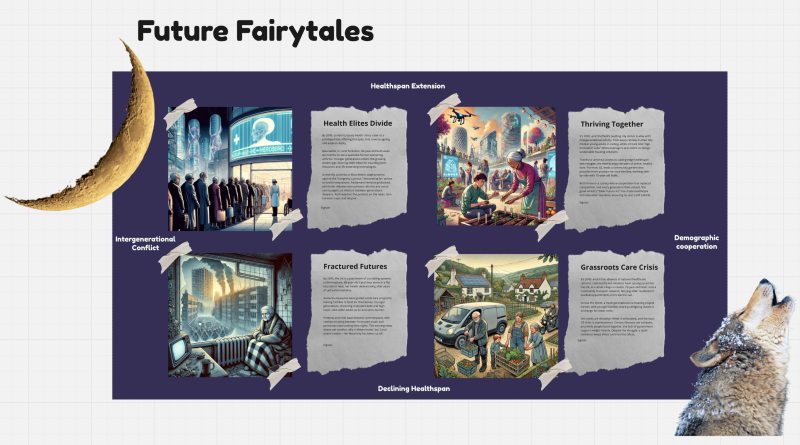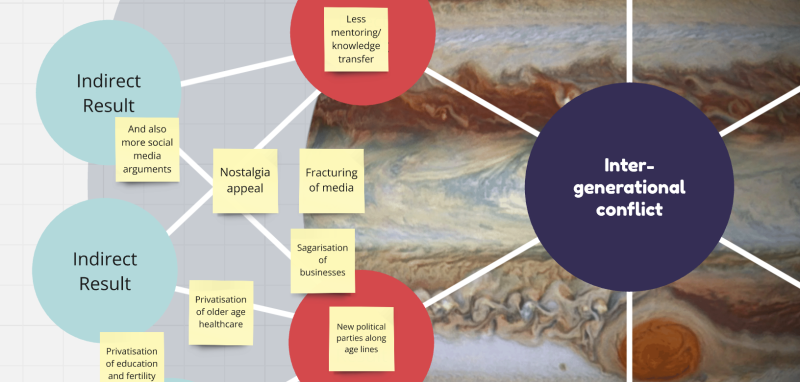Christian Graham24 Nov 2024
We’re currently exploring the trend of an ageing population, considering its impact on Friends of the Earth and determining if and how we should intervene, through a series of workshops. We’ve also been experimenting extensively with AI as a supportive partner to amplify our thinking and enhance our processes.
Here are some of my insights in using AI in this practice so far.
AI as a trusted finisher
I’ve come to see AI as a second pair of eyes —a way to catch anything we might have missed and ensure nothing important is overlooked. For instance, in preparation for our Futures activity, I uploaded screenshots of our 3 horizons activity into ChatGPT to generate a list of key drivers based on them. Then I asked AI to check if we’d missed anything—and sure enough, nine more key drivers came to light.
AI’s strength lies in synthesis and in ensuring we don’t miss something critical. It doesn’t replace our creative work - it complements it, making our foundation more solid and comprehensive.
Humans first for idea generation
Occasionally, I've experienced reduced focus when using AI for idea generation. The volume is huge and quality is often good enough, but lacks a certain kind of warmth, depth and even quirky richness only humans can provide. The result is feeling overwhelmed and a kind of paralysis. The exact opposite of what I need from a thought partner.
In one of our workshops, we used a Futures Wheel—a brainstorming tool—to map out the direct and indirect consequences of intergenerational conflict. Initially, we felt a bit stuck and it was tempting to rely on AI right from the start to give us a list of consequences. But instead, we chose to jump in ourselves, mapping things out with sticky notes, getting hands-on first - and only then considered bringing AI into the mix.
There are probably different ways we could have used AI here, e.g. to give us hints and clues of where to start - which would help us get unstuck more quickly, but without handing over our creative spark.
Clustering without bias
Clustering ideas can easily be influenced by personal bias. We naturally see patterns through the lens of our own experience, which can lead to clusters that don’t reflect the true data.
This is where AI shines. I was able to take output from previous workshops and get the AI to cluster them. It was near flawless each time. The clusters that emerged felt real, free from personal bias and brought clarity that otherwise might have been lost. AI offered a fresh, fair perspective to our work.
Real-time summaries
Sometimes, insights happen by accident. Ahead of one of our workshops, we already had a lot of material—SWOT analyses, outline attempts at problem statements, three horizons mapping —it all added up. During a short break, I decided to feed screenshots of our output into the AI to create a problem summary.
The result? A cohesive, albeit lengthy, draft that captured the essence of everything we’d discussed. The real magic was that it felt wholly authentic. Reading it, I could hear different colleagues' voices within it. It wasn’t just a summary - it was validation. And, importantly, it freed us from holding onto all those details, allowing us to focus on what came next.
It's easy to imagine a future where AI quickly refines workshops during breaks, based on what just happened.
Keeping creativity flowing
Flow is that optimal mental state where you feel completely absorbed in what you're doing. It's characterised by a sense of effortless involvement, energised focus and a feeling that time either flies by or almost stands still. Achieving flow often leads to peak creativity and productivity, making it invaluable for collaborative and innovative work.
During these workshops, I've discovered how valuable AI can be for keeping myself in a state of creative flow during lengthy online workshops. In moments when ideas dried up or conversations stalled, I'd ask it to reframe a question, help provide a summary or offer a different perspective. For example, while facilitating I would sometimes put in a segment of the live transcript and ask it to suggest a follow up question.
What's next?
Where might AI help us with future deep dives? Picture an AI listening in, giving on-the-fly suggestions, or pointing out areas that need more focus—all in real time. This kind of support could help us push our thinking further and ensure nothing is missed.
What are some ways you are using AI in your innovation practice? Or are you exploring the topic of population ageing too? Do drop us a line and let us know.



